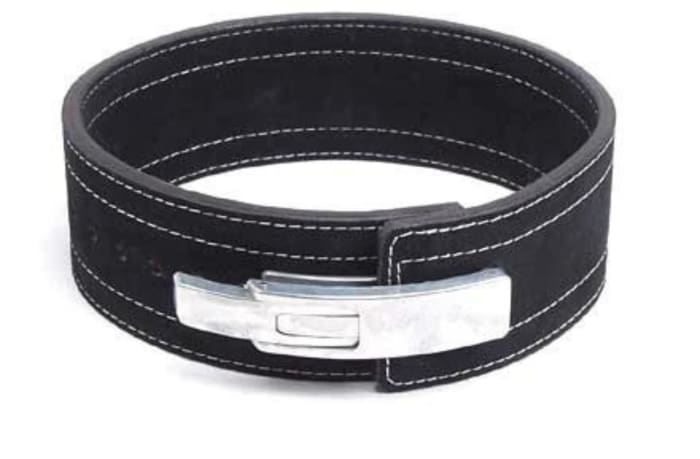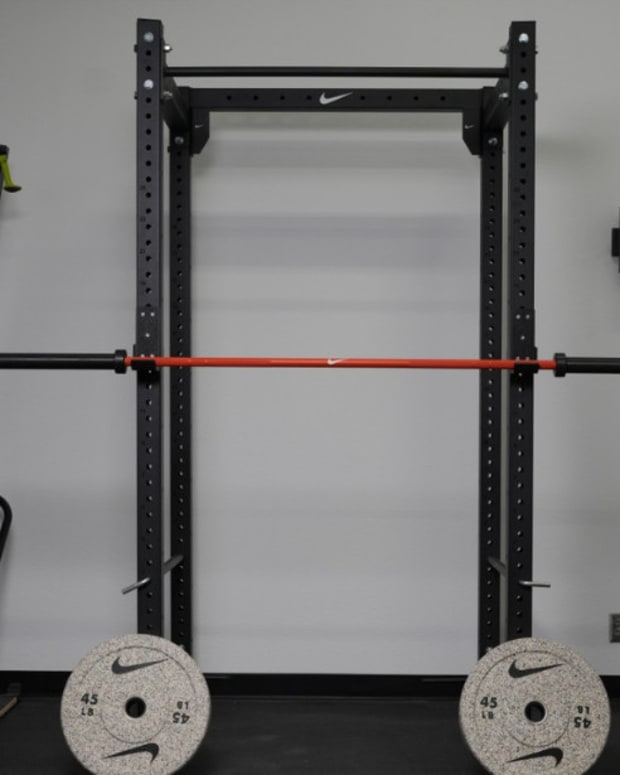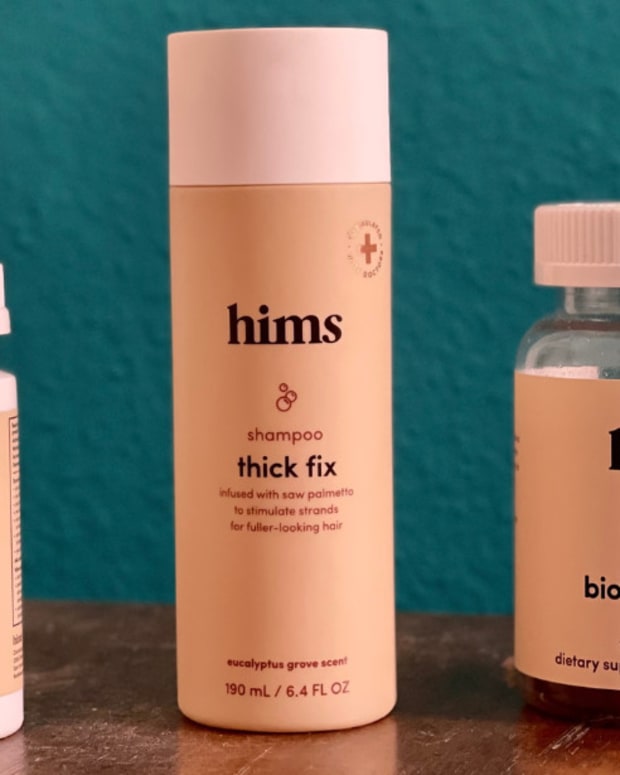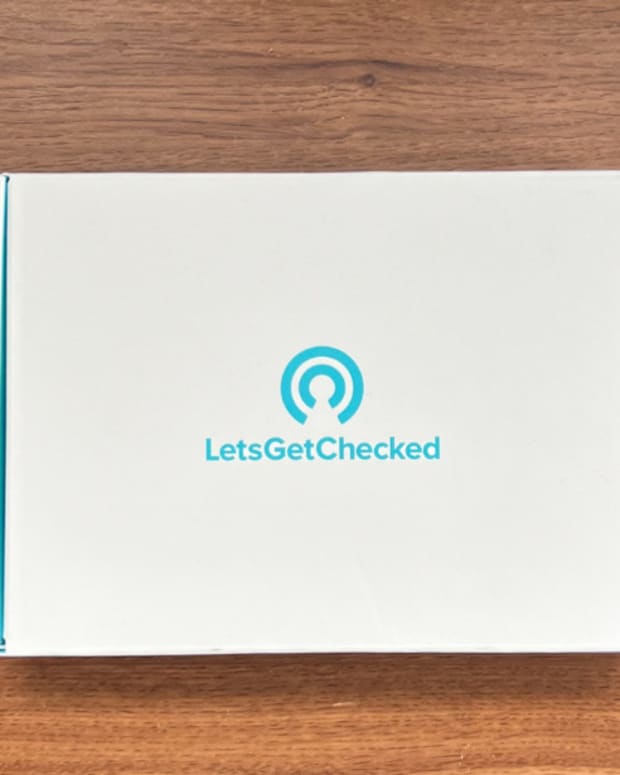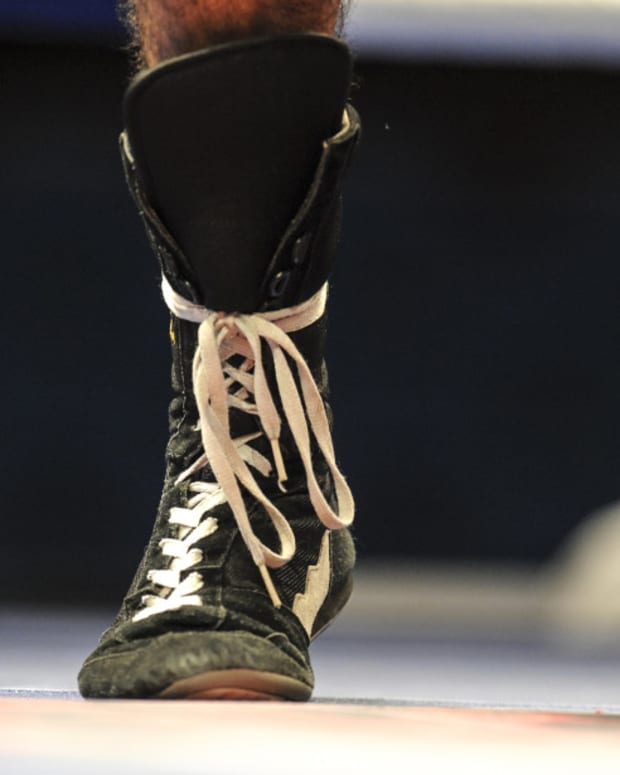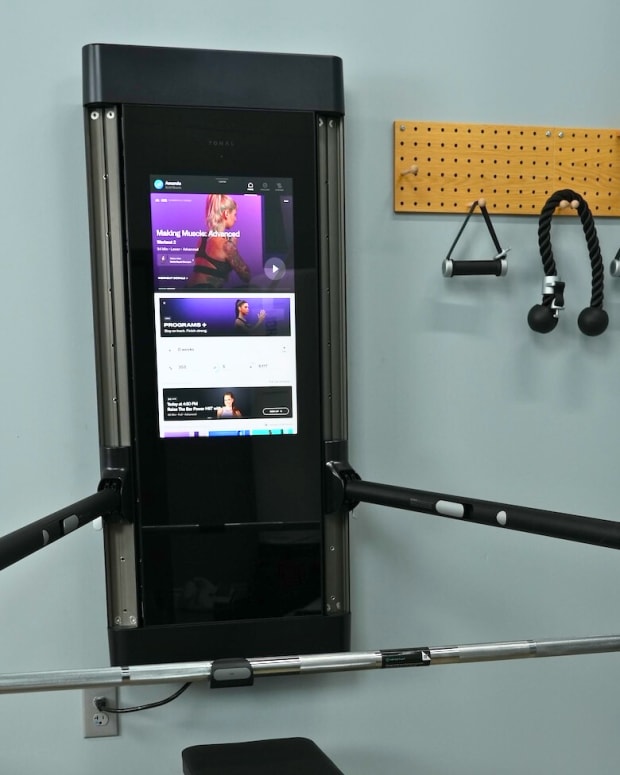The products featured in this article have been independently reviewed. When you buy something through the retail links on this page, we may earn commission at no cost to you, the reader. Sports Illustrated editorial staff are not involved in the creation of this content. Learn more here.
A weightlifting belt doesn’t lend you superhuman strength, but it can help you better tap into the strength you already have. How? For starters, it reinforces proper form, bracing your core so you activate more muscles and can generate more force. (FYI: That will translate to more strength when you lift without the belt, too.) It also relieves the pressure on your back when you’re lifting heavy, helping you avoid injury that might sideline you from the weight room. And belts are one of the more affordable tools you can invest in when it comes to heavy lifting—you can actually find options as affordable as a single dumbbell. The belts on this list will help you get the most out of every rep.
Our Picks for the Best Weightlifting Belts of 2024:
- Best Leather Weightlifting Belt: Rogue Faded 4” Lifting Belt by Pioneer
- Best Belt for Olympic Weightlifting: Eleiko Olympic Lifting Belt
- Best CrossFit Weightlifting Belt: 2POOD 4” Weightlifting Belt
- Best Budget Weightlifting Belt: Harbinger 4” Nylon Lifting Belt
- Best Velcro Weightlifting Belt: Schiek 2004 Weightlifting Belt
- Best Lever Weightlifting Belt: Gymreapers 10mm Lever Belt
- Best Weightlifting Belt for Back Support: IronBull Strength 10mm Weightlifting Belt
- Best Weightlifting Belt for Women: Inzer Forever Lever Weightlifting Belt
- Best Weightlifting Belt for Men: REP Lifting Belt
Best Leather Weightlifting Belt: Rogue Faded 4” Lifting Belt by Pioneer
Key Features:
- Four inches wide
- 8.5mm thick
- Made from 100% vegetable tanned sole leather with a black suede liner
- $140
Rogue is one the biggest names in the weightlifting world, so it should come as no surprise that its belt tops this list. A four inch wide belt that accommodates waist sizes from 22 inches to 48 inches, this leather belt uses a patent-pending design that allows for a more personalized fit than competitors. Instead of the standard one inch increments for the belt prongs, you’ll find two offsetting lines of holes that allow for half-inch increments. These belts tend to run one size larger than other weightlifting belts, so you may want to size down.
Pros:
- Allows for half-inch adjustments
- 8.5-millimeter thickness allows for versatility
- Faded leather design
Cons:
- Tends to run larger than standard belt sizing
- May not be thick enough for powerlifters
- More expensive
Best Belt for Olympic Weightlifting: Eleiko Olympic Lifting Belt
Key Features:
- Four inches wide
- 10mm thick
- Made from high-quality and durable vegetable-tanned leather
- $113
Olympic lifting is a more technical variation of weightlifting, and training revolves around two main compound lifts: the snatch and the clean and jerk. For those kinds of movements, you need a tapered belt design that allows for more flexibility and mobility in the front while still providing lots of support in the back. Eleiko’s handcrafted four-inch belt tapers to two inches in the front and provides a rigid 10mm of thickness all around for superior stability. The double stitching around the edges increases the durability. You’ll have this belt for life.
Pros:
- Very rigid for support and stability
- Competition-certified
- Uses a double-prong buckle in standard one-inch increments for a secure fit
Cons:
- Takes a while to break in
- May be too rigid for some people
- Tapered design is not for everyone
Best CrossFit Weightlifting Belt: 2POOD 4” Weightlifting Belt
Key Features:
- Four inches wide
- Made from high-quality nylon
- Velco plus steel buckle and hook-and-loop fastening system
- $64.99
A CrossFit belt should be all about versatility, so you can easily move from heavy lifting to cardio movements depending on the WOD. Nothing’s easier to put on and take off in a hurry than Velcro, which 2POOD combines with a quick-locking, easy-adjust steel buckle and hook-and-loop fastening system that provides added security so the belt doesn’t pop off during your reps. It may not offer quite the same level of stability as leather, but the thick nylon can still stand up to whatever your WOD throws at you.
Related Post: The Best Crossfit Equipment for Your Home Gym
Pros:
- Breaks in quickly
- High-quality nylon will outlast cheaper nylon belts
- Buckle system increases durability of Velcro
Cons:
- Not as durable or stiff as leather belts
- Not for heavy lifters
Best Budget Weightlifting Belt: Harbinger 4” Nylon Lifting Belt
Key Features:
- Four inches wide
- Made from heavy-duty nylon web
- Velco plus steel buckle and hook-and-loop fastening system
- $23.97
CrossFitters and casual weightlifters may prefer a nylon weightlifting belt, because it’s a little more flexible and versatile than a stiff leather belt and generally features a Velcro enclosure, which allows for a more customized fit and easier adjustments. This affordable option from Harbinger adds an extra layer of lower back and abdominal support courtesy of a three-inch wide belt strap that bolsters the nylon webbing. The soft inner lining may not be as supple as leather, but it won’t cause any skin irritation or chafing, so you can stay focused on your reps.
Pros:
- Extra thick Velcro strap provides maximum support
- Flexible nylon allows for more mobility
- Comfortable inner lining
Cons:
- Waist sizing only goes up to 42 inches
- Not meant for advanced weightlifters
- Not as rigid or durable as leather belts
Best Velcro Weightlifting Belt: Schiek 2004 Weightlifting Belt
Key Features:
- Unique cone shaped design
- 4.75 inches wide at the back
- Nylon with Velcro fastener
- $62.95
Schiek’s belts feature a unique cone shape, meaning it’s thicker on the back and front but skinnier on the sides, where you need less support. It’s constructed from heavy-duty nylon, and features the company’s patented One-Way Velcro system: Instead of a single set of Velcro pads, this belt has one on the webbing and one on the core frame (which can slide in only one direction), allowing you to easily get the tightest fit without stressing about whether you’ll bust out of the belt during a super heavy set of reps.
Pros:
- Lumbar insert reinforces support at the spine
- Two Velcro layers for security
- Waist sizes available up to 62 inches
Cons:
- More expensive than other nylon belts
- Not as rigid or durable as leather belts
Best Lever Weightlifting Belt: Gymreapers 10mm Lever Belt
Key Features:
- Four inches wide
- 10mm thick
- Made from high-quality leather
- $120
With a lever belt, you find the best fit around your waist and then screw in an attachment that makes it easy to quickly tighten the belt for maximum support and rapidly release it when your reps are done. Add that feature to Gymreapers stiff leather construction, and you’ve got a belt that will deliver a consistently tight fit even under the most intense conditions (PR day, anyone?). And while some leather belts can dig into your skin thanks to their rigid structure, Gymreapers’ features smooth, rounded edges and interior suede liner for moisture control.
Pros:
- Rounded edges provide a more comfortable fit
- Interior suede liner for moisture control
- 13mm thick version also available for $10 more
Cons:
- Can take awhile to break in
- Comes unassembled
- Will have to manually reset lever to adjust waist size
Best Weightlifting Belt for Back Support: Iron Bull Strength 10mm Weightlifting Belt
Key Features:
- Four inches wide
- 10mm thick
- Made from suede leather
- $80
All weightlifting belts should support your back, and the Iron Bull Strength Powerlifting Belt does so in style—whether you’re powerlifting, as the name implies, or Olympic lifting. With four inches of height across its length, your back, abs, and entire core will be evenly stabilized for extra power and strength. The double-prong belt buckle reinforces even weight distribution across your torso, and the suede leather won’t rough up your skin (and will confirm to your body shape after a breaking in period). It comes in seven colors, and in waist sizes up to 50 inches.
Pros:
- Cut from one solid piece of suede leather
- Double buckle prongs are made from zinc-plated steel for strength and durability
- Ten rows of punch holes for the buckle
Cons:
- Stiff edges may cause discomfort
- Takes a while to break in
- Sizing on website can be confusing
Best Weightlifting Belt for Women: Inzer Forever Lever Weightlifting Belt
Key Features:
- 10mm thick
- Made from a single piece of leather
- Has a suede, non-slip finish
- $119.95
Inzer has been making weightlifting belts for decades, and a single purchase from them can last you just as long. This belt is made from one strip of leather that conforms to your body over time, and finished with a layer of non-slip suede attached with four rows of lock-stitched, corrosion-resistant, high-density nylon—meaning there’s no way that’s going to separate from the leather. The company says its lever buckle can be adjusted up to three inches tighter than with a standard buckle, providing a super secure fit that will support even your toughest lifts.
Pros:
- Waist sizes extend from 22 inches to 58 inches
- Lever fastener allows it to be adjusted up to three inches tighter than a standard buckle
- 13mm thick version available for $10 more
Cons:
- Takes a while to break in
- Non-rounded edges may cause discomfort
- Will have to manually reset lever to adjust waist size
Best Weightlifting Belt for Men: REP Lifting Belt
Key Features:
- Four inches wide
- 10mm thick
- Made from vegetable-tanned leather
- $79.99
The REP Lifting Belt is a dupe for the Rogue Ohio Lifting Belt—except it rings up at $50 cheaper. Unlike most leather belts, this one (which is made from vegetable tanned leather) requires no breaking in period. Take it out of the box, cinch it around your waist using whichever one of the 10 prong holes that fits you best, and start banging out reps. No matter how intense your lifting session, your sweat won’t ruin the leather; the edges are burnished and sealed for superior moisture resistance. Double stitching on the sides extends the lifespan.
Pros:
- Quick break-in period
- Multiple design features enhance durability
Cons:
- One-inch belt increments may be difficult for those between sizes
- Single-prong belt buckle may be less durable than double-prong
Why Buy a Weightlifting Belt?
Weight lifting belts get a bad rap as a “crutch,” in that they’re supporting your torso so your abdominal muscles don’t have to. But research has shown that untrained lifters demonstrated 17 percent more activity in their spinae erector muscle—a group of long muscles that run up the back along the spine (and are considered a part of your core)—when using a belt. Weightlifting belts can also increase muscle activity of the rectus abdominis (the long muscle that is visible under skin and can look like a six-pack in people with low body fat), another study found. The more muscle you engage, the better your stability and the more force you can generate. And greater muscle activation leads to greater gains.
Related Post: 10 Best Lifting Straps for Weightlifting
The rigid structure of a belt also keeps your back from hyperextending—or overarching—during certain exercises (and can also prevent side to side motion). This is especially important during heavy lifting, because putting too much stress on the lower back can lead to pain, swelling, muscle spasms, reduced or limited range of motion and loss of strength. During certain exercises, like deadlifts and squats, a weightlifting belt reinforces proper form so you’re lifting with your legs, not your back. That’s going to help you lift strong without putting undue pressure on any other body parts.
But it may just come down to the placebo effect—which can be incredibly powerful. Even if muscle activity is unaffected, some lifters reported feeling more confident while wearing a belt according to a study published in 2022.
How to Use a Weightlifting Belt
A weightlifting belt should sit just above your hip bones, so it’s encasing your midsection. The key is in the fit: It should feel as tight as possible still allowing you to take a deep belly breath (a general rule of thumb is that you should be able to slide your thumb in between the belt and your stomach). Once the belt is on and you’re ready to start a lift, you need to brace your core; that means taking a deep breath and flexing every muscle in your stomach, as if someone just punched you in the gut. Think about pushing your midsection against the interior of the belt, and maintain that position as you execute the lift. If you’ve never used a weightlifting belt before, though, you should work with a certified coach who can help you learn how to use one.
What Makes a Good Weightlifting Belt?
Construction
Belts are pretty simple tools, but most fall into two popular design buckets. A cylindrical belt is the same width all around, which supports the back, abdomen, and sides equally; these are generally used in powerlifting. Olympic lifters may use tapered weightlifting belts, which are wider in the back and thinner towards the abdomen, allowing for more support in the back and mobility in the front.
Fastener
To some extent, this comes down to personal preference and the style of lifting you do. A buckle belt is a classic, because once it’s on, it will feel super secure (however, it can be difficult to get it as tight as you need, and you’re limited to whatever increments are available on the belt). With a lever belt, you size up the fit once, adjust the lever attachment to the correct setting, and all you need to do is close the lever to get ready to lift. And then there’s Velcro, the easiest and most customizable option, but the least secure and the least durable; it’s typically best for CrossFitters or very casual lifters.
Size
There are a couple sizes to consider when looking at a weightlifting belt. First, know the size of your waist. Belts generally measure between 22 inches and 56 inches in length. Then, consider your height. A four-inch tall belt is best for shorter people, while taller people might prefer a six-inch belt. Finally, there’s the thickness of the belt. Different levels of thickness will provide you with different levels of support and protection: A 6.5mm belt will be more flexible, allowing for greater mobility and range of motion during lifting (this thickness is generally best for Olympic weightlifters, bodybuilders, and general gym-goers). A 10mm belt is stiffer and provides more stability, which can be more supportive (which is why powerlifters and advanced bodybuilders veer towards this style). Unless you’re lifting seriously heavy weights, you don’t need a belt over 10mm thick.
Cost
As far as weight room equipment goes, weightlifting belts are definitely on the more affordable end of the spectrum. You can find belts ranging from as low as $20 to upwards of $150. The cost will mostly depend on what materials are used, which affects the sturdiness and lifespan of the product. Those higher-end belts will provide top-notch support and likely last forever, which may not be the case for some more budget-friendly options.
FAQs
Is a thicker belt better for lifting?
A thicker belt is inherently stiffer, which provides more stability and support and makes you less likely to injure your back during heavier lifts. However, it may not allow for as much mobility in certain movements because of that stiffness, which could be uncomfortable. Most general gym-goers should be fine in a 6.5mm belt, but if you’re focused on powerlifting or you’ve graduated to heavier loads, then a thicker belt may be more beneficial.
Do lifting belts help bench press?
Proper breathing and bracing of the abdomen is just as important in a bench press as it is during an upright lift, and a belt can provide real-time form feedback. It can also support your lower back, and help keep you from overarching during the exercise.
Should you squat without a belt?
You can absolutely squat without a belt. A belt can be an external reminder of proper form, but it’s just as important to learn that form without that kind of cue. If you’re lifting lighter loads, you likely won’t need a belt. But as you progress, and if your goal is to lift as much weight as possible and maximize your performance, you will eventually want to squat with a belt.
Related Post: The Best Weightlifting Shoes for Every Weightlifting Exercise
Final Thoughts
Both beginners and experienced lifters can benefit from a belt: For those new to the weight room, a weightlifting belt serves as a physical reminder of proper form so you can engage your muscles and optimize each rep. And for those who are looking to maximize their gains, a weightlifting belt can help support your performance so you can push your limits without worrying about overstressing your body.
Prices are accurate and items in stock as of publish time.








